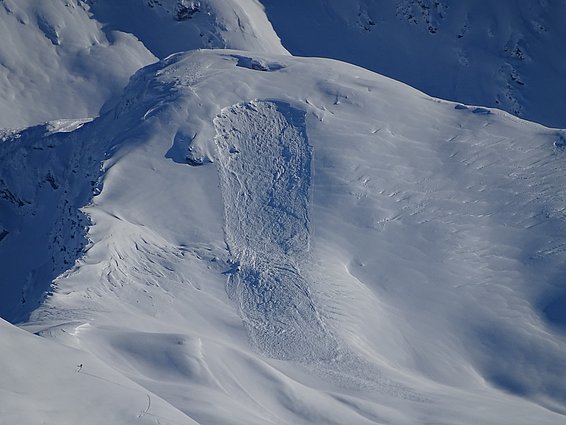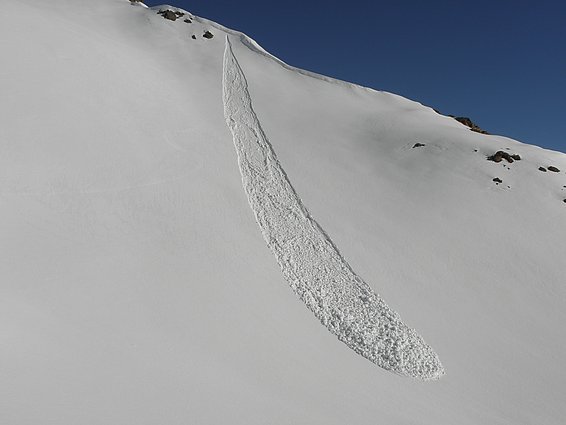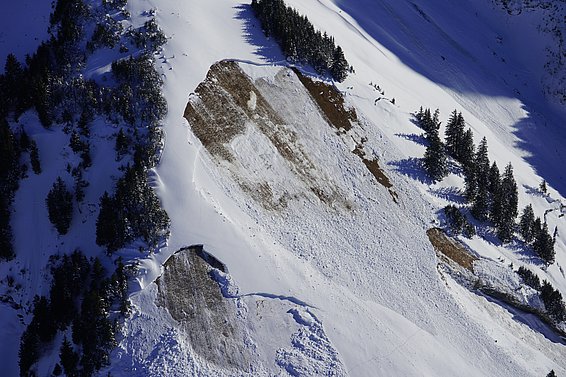Slab avalanches ¶
Slab avalanches have a distinct fracture line. They can only occur when a bonded snow layer (the 'slab') lies on top of a weak layer. Initially when the avalanche is triggered, a small fracture, or initial failure, arises in the weak layer, and this is then quickly propagated along the layer. The extent of this propagation depends largely on the characteristics of the weak layer and those of the slab. As a result, the entire slab releases over a large area.
Slab avalanches can occur in dry or wet snow, even long after any snowfall. They can be released naturally (without human assistance), or by any point inside or even outside the slab (remote triggering).
Slab avalanches are the most dangerous avalanche type, accounting for over 90% of avalanche fatalities. They can quickly reach a high speed. If skiers trigger such an avalanche, they often find themselves right in the middle of it and are frequently caught by it.
Loose-snow avalanches ¶
Loose-snow avalanches have a distinct trigger point from which they fan out as they plummet downhill and the released snow sweeps more and more snow with it. This type of avalanche often occurs during or shortly after snowfall or when the snow warms up a lot. In the case of dry (powder) snow, this usually requires a 40° gradient at the trigger point. Espeically in wet sonw, these avalanches can reach considerable sizes in persistently steep terrain.
Loose-snow avalanches are often released naturally. They claim fewer than 10% of avalanche fatalities, with many of these occurring in the summer with mountaineers in the steep terrain being swept away, causing them to fall. Normally, snow sports enthusiasts triggering a loose-snow avalanche are not buried by the snow, as the avalanche sweeps under them.
Gliding avalanches ¶
Like slab avalanches, gliding avalanches have a distinct fracture line, but here the whole snowpack slides away. This is only possible on a smooth substrate, typically consisting of grass or slabs of rock. The steeper the slope, the more likely the snow is to slide.
Gliding avalanches can be a major problem for transport routes particularly in snowy winters. For winter sports enthusiasts, they are of less importance as they are not triggered by people but are released naturally. A prerequisite for such gliding snow is that the very base of the snow, at the interface with the ground, is moist, meaning there is little friction. In this context there are two ways in which water enters the lowermost layer:
- In mid-winter, the snowpack is generally cold and dry. Then the snowpack becomes moist from below: the warm ground melts the snow lying above it, or the snow sucks water out of the moist ground. In mid-winter, gliding avalanches are possible at any time of the day or night.
- At some point in springtime, the whole snowpack warms up to 0 °C. This allows melt water and rain to seep through the entire snowpack and means that its base is moistened from above. In these conditions, gliding avalanches often occur in the typical wet-snow avalanche periods and their frequency increases in the latter part of the day.
Often, but by no means always, the gliding of the snowpack begins slowly, starting with gaps ('glide cracks') forming within it. These can suddenly lead to a gliding avalanche. It is impossible to predict exactly when this will happen, so it is best to avoid staying close to (whether above, adjacent to or below) glide cracks for any longer than absolutely necessary.


